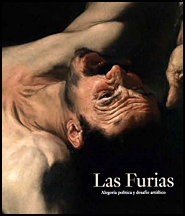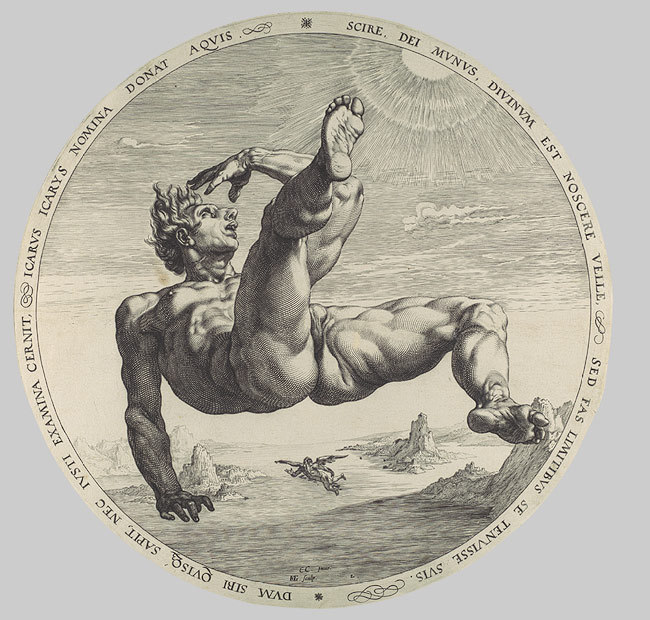The Museo del Prado is presenting The “Furias,” 21 January to 4 May 2014. From Titian to Ribera. Sponsored by the Fundación Amigos del Museo del Prado, the exhibition analyses the rise, evolution and decline of the subject of the “Furias”, from the time of its appearance in European art in the mid-16th century to the late 17th century.
The exhibition includes 28 works, including a drawing by Michelangelo loaned from the Royal Collection in London and paintings by Rubens, Rombouts, Goltzius, Assereto, Rosa and Langetti. Also on display are the Prado’s versions of the “Furias” by Titian and Ribera and its Tityus enchained by Gregorio Martínez, acquired in 2011.
Together, these works illustrate the success enjoyed for 120 years by the subject of the “Furias” at a time when rulers used them as political allegories and painters saw them as an ideal vehicle for illustrating supreme mastery in art, both in a formal sense, given that they are huge, nude figures in improbable foreshortenings, and in expressive terms, as the most overt representation of suffering.
The “Furias”. From Titian to Ribera offers an in-depth analysis of the Renaissance and Baroque’s interpretation of antiquity and looks at the circulation and exchange of artists, works and aesthetic ideas across Europe in the 16th and 17th centuries. In addition, it encourages a reflection on why certain forms acquire meanings that are passed down from one generation to the next.
Divided into five sections, the exhibition includes 2 drawings, 8 prints, 1 medal and 16 paintings and centers on a copy of the Laocoön from the Museo de Escultura in Valladolid.
The first section looks at the only iconographic precedent for the group commissioned from Titian, which is a drawing of Tityus by Michelangelo of 1532, exhibited for the first time in Spain.
A view of the Great Hall in the palace at Binche, created to welcome Charles V and Prince Philip, opens the second section, which is devoted to the group commissioned from Titian by Mary of Hungary.
The third section looks at Haarlem and Antwerp in the final years of the 16th century and the early 17th century when these cities were the first centres for the reception of the subject of the Furias, based on the Laocoön.
The fourth section illustrates the subject’s “return” to Italy, the role played by Flemish and Dutch artists in this process and the importance of Naples as the Baroque capital of the Furies with Ribera as their maximum exponent.
The exhibition ends with the dissemination of the subject across Italy, terminating in Venice with Langetti and the tenebrosi and thus closing a circle initiated by Titian.
The “Furias” first appeared as a group in art in 1548 when Mary of Hungary commissioned Titian to paint four canvases for her palace at Binche (on the outskirts of Brussels) depicting Tityus, Tantalus, Sisyphus and Ixion, figures whom she associated with the German princes who had rebelled against her brother, the Emperor Charles V, and whom he had defeated the year before at Mühlberg.
In Spain, the name the “Furias” was applied to four figures who dwelled in the Graeco-Roman Hades as a punishment for defying the gods: Tityus, whose liver was constantly pecked at by a vulture for attempting to rape one of Zeus’s lovers; Tantalus, condemned to vainly try to obtain food and drink for serving up his son at a banquet of the gods; Sisyphus, who had to endlessly roll an enormous rock for revealing Zeus’s infidelities; and Ixion, obliged to turn forever on a wheel for attempting to seduce Hera. Strictly speaking, the Furies were female figures who personified punishment and vengeance and were responsible for ensuring that those in Hades underwent their punishments. In Spain, however, and from the 16th century onwards the name was used for Titian’s canvases of Tityus, Ixion, Tantalus and Sisyphus, and the term thus became used for the subject in general.
The “Furias” became a popular iconography in the 120 years after their first appearance, taking on further meanings in addition to their original, political one. From the late 16th century onwards the subject was considered highly appropriate for illustrating supreme mastery in art, given that they are monumental, nude figures in complex foreshortenings and also represent extreme suffering, which appealed to the Baroque sensibility. They were thus used by leading artists such as Rubens, Goltzius and Van Haarlem to demonstrate their skills, and by Ribera and Rombouts to give visual form to the aesthetic of horror in vogue in Europe at the time. However, after a peak of interest in Naples with Ribera and in Venice with Langetti, from around 1680 artists began to make less use of this subject, which was replaced around 1700 by others that allowed similar concepts to be expressed.

The accompanying catalogue is entirely written by Miguel Falomir, curator of the exhibition and Head of the Department of Italian and French Painting (up to 1700) at the Museo del Prado. It includes the following chapters: “Titian, Mary of Hungary and Political Allegory: on monarchs, traitors and vengeful lovers”; “The Artistic Challenge. Improbable foreshortenings and exaggerated expressions”; and “Originality and Imitation: classical and modern artists”. Paperback 192 Pages 24 x 28 cm Spanish and English Publisher Castellano ISBN 978-84-8480-282-2
Images:

1.Tityus
Michelangelo Buonarroti
Charcoal and black chalk on paper, 33 x 19 cm
1532
London, Royal Collection Trust / ©Her Majesty Queen Elizabeth II 2014

2. The punishment of Tityus
Anonymous Italian( Nicolás Beatrizet)
Engraving, 30.5 x 45 cm
XVI Century
Madrid, Biblioteca Nacional de España
3. The punishment of Tityus
Gregorio Martínez
Oil on canvas, 173 x 233 cm
1590 - 1596
Madrid, Museo Nacional del Prado
4. Fight between Jupiter and the Titans
Leone Leoni
Silver medal, diameter: 73,5 mm.; weight: 180,98 gr
1538?
Madrid, Museo Nacional del Prado

5. Tantalus
Giulio Sanuto
Engraving, 44.2 x 34.1 cm
1565
Budapest, Szépművészeti Múzeum

6.Sisyphus
Titian
Oil on canvas, 237 x 216 cm
1560 - 1565
Madrid, Museo Nacional del Prado
7. Tityus
Titian
Oil on canvas, 253 x 217 cm
1560 - 1565
Madrid, Museo Nacional del Prado
8. Tityus or Prometheus chained to the Caucasus
Cornelis Cort
Engraving, 45 x 37 cm
1566
Madrid, Biblioteca Nacional de España

9. Tityus
Cornelisz van Haarlem
Ink on paper, 36 x 26.8 cm
1588
Vienna, Albertina
10. Tityus
Goltzius
Oil on canvas, 125 x 105 cm
1613
Haarlem, Frans Hals Museum
_-_Prometheus_Bound_-_Google_Art_Project.jpg/667px-Peter_Paul_Rubens,_Flemish_(active_Italy,_Antwerp,_and_England)_-_Prometheus_Bound_-_Google_Art_Project.jpg)
11. Prometheus Bound
Peter Paul Rubens and Frans Snyders
Oil on canvas, 242.6 x 209.5 cm
c. 1611
Philadelphia, Philadelphia Museum of Art

12. Ixion
Cornelisz van Haarlem
Oil on canvas, 192 x 152 cm
1588
Rotterdam, Museum Boijmans van Beuningen

13. Tantalus
Cornelisz van Haarlem / Goltzius, Heindrick
Engraving, 31 cm diameter
1562 - 1638
Amsterdam, Rijksmuseum

14. Ixion
Cornelisz van Haarlem / Goltzius, Heindrick
Engraving, 33 cm diameter
1562 - 1638
Amsterdam, Rijksmuseum

15. Phaeton
Cornelisz van Haarlem / Goltzius, Heindrick
Engraving, 33.5 cm diameter
1562 - 1638
Amsterdam, Rijksmuseum

16. Icarus
Cornelisz van Haarlem / Goltzius, Heindrick
Engraving, 34.2 cm diameter
1562 - 1638
Amsterdam, Rijksmuseum
_-_Prometheus_-_KMSK_Brussel_25-02-2011_12-45-49.jpg/800px-Theodoor_Rombouts_(1597-1637)_-_Prometheus_-_KMSK_Brussel_25-02-2011_12-45-49.jpg)
17. Prometheus
Theodoor Rombouts
Oil on canvas, 154 x 222.5 cm
Brussels, Royal Museum of Fines Arts of Belgium

18. Ixion
José de Ribera
Oil on canvas, 220 x 301 cm
1632
Madrid, Museo Nacional del Prado
19. Tityus
José de Ribera
Oil on canvas, 227 x 301 cm
1632
Madrid, Museo Nacional del Prado